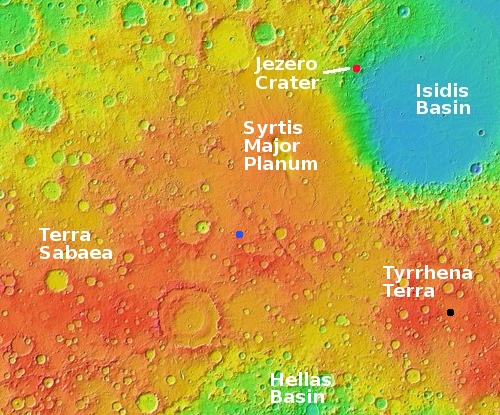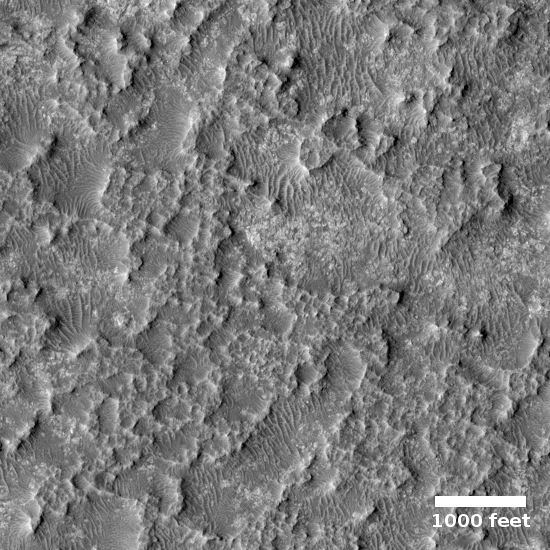The dry barren plains of Tyrrhena Terra
In a sense today’s cool image is a replay of one I posted in March, showing the dry barren terrain in the vast rough cratered highlands of Tyrrhena Terra, located along the equator of Mars between the giant basins of Isidis and Hellas.
Today’s image on the right, cropped to post here, was taken by the high resolution camera on Mars Reconnaissance Orbiter on March 26, 2020, and shows well the barrenness of this region. The surface appears quite solid, like bedrock, rather than the squishy soft surface of the northern lowland plains. Moreover, there is a lot of dust trapped in the low areas between the ridges, forming ripples that new data suggest move slowly across the surface. If you click on the full image, you will see that this terrain is far from local, and goes on in this manner for quite a distance in all directions.
This is a dry and forbidding place, about the size of the American southwest, from Texas to California.
The overview map below provides some context of Tyrrhena Terra’s location on Mars.

The blue dot near the center indicates this image’s location. The black dot on the right is the location of the similar image posted in March. As I wrote in that March post,
Located in the equatorial regions, the data has so far found little obvious evidence of ice or water, making it less appealing as a site for settlement. The roughness is an even bigger strike against this territory. Even if we did eventually find ice here, getting to and from this region will discourage exploration. There are many other places on Mars where water is well documented, near the surface, and where landing and moving about is far less difficult.
So, let me predict the far future, when humans have built many colonies on Mars. While the big cities will be in the wet northern plains, preferably at spots closest to the equator, this region will remain a rural backwater, where few people live or work.
Despite this apparent barrenness, it would be a big mistake to ignore this region and not explore it. It could very well be that Mars’ most valuable mineral resources are buried here. Just like on Earth, sometimes the most valuable mines are located in some of the most inhospitable places. And you can’t find them if you don’t brave that wilderness and look.
On Christmas Eve 1968 three Americans became the first humans to visit another world. What they did to celebrate was unexpected and profound, and will be remembered throughout all human history. Genesis: the Story of Apollo 8, Robert Zimmerman's classic history of humanity's first journey to another world, tells that story, and it is now available as both an ebook and an audiobook, both with a foreword by Valerie Anders and a new introduction by Robert Zimmerman.
The print edition can be purchased at Amazon or from any other book seller. If you want an autographed copy the price is $60 for the hardback and $45 for the paperback, plus $8 shipping for each. Go here for purchasing details. The ebook is available everywhere for $5.99 (before discount) at amazon, or direct from my ebook publisher, ebookit. If you buy it from ebookit you don't support the big tech companies and the author gets a bigger cut much sooner.
The audiobook is also available at all these vendors, and is also free with a 30-day trial membership to Audible.
"Not simply about one mission, [Genesis] is also the history of America's quest for the moon... Zimmerman has done a masterful job of tying disparate events together into a solid account of one of America's greatest human triumphs."--San Antonio Express-News
In a sense today’s cool image is a replay of one I posted in March, showing the dry barren terrain in the vast rough cratered highlands of Tyrrhena Terra, located along the equator of Mars between the giant basins of Isidis and Hellas.
Today’s image on the right, cropped to post here, was taken by the high resolution camera on Mars Reconnaissance Orbiter on March 26, 2020, and shows well the barrenness of this region. The surface appears quite solid, like bedrock, rather than the squishy soft surface of the northern lowland plains. Moreover, there is a lot of dust trapped in the low areas between the ridges, forming ripples that new data suggest move slowly across the surface. If you click on the full image, you will see that this terrain is far from local, and goes on in this manner for quite a distance in all directions.
This is a dry and forbidding place, about the size of the American southwest, from Texas to California.
The overview map below provides some context of Tyrrhena Terra’s location on Mars.

The blue dot near the center indicates this image’s location. The black dot on the right is the location of the similar image posted in March. As I wrote in that March post,
Located in the equatorial regions, the data has so far found little obvious evidence of ice or water, making it less appealing as a site for settlement. The roughness is an even bigger strike against this territory. Even if we did eventually find ice here, getting to and from this region will discourage exploration. There are many other places on Mars where water is well documented, near the surface, and where landing and moving about is far less difficult.
So, let me predict the far future, when humans have built many colonies on Mars. While the big cities will be in the wet northern plains, preferably at spots closest to the equator, this region will remain a rural backwater, where few people live or work.
Despite this apparent barrenness, it would be a big mistake to ignore this region and not explore it. It could very well be that Mars’ most valuable mineral resources are buried here. Just like on Earth, sometimes the most valuable mines are located in some of the most inhospitable places. And you can’t find them if you don’t brave that wilderness and look.
On Christmas Eve 1968 three Americans became the first humans to visit another world. What they did to celebrate was unexpected and profound, and will be remembered throughout all human history. Genesis: the Story of Apollo 8, Robert Zimmerman's classic history of humanity's first journey to another world, tells that story, and it is now available as both an ebook and an audiobook, both with a foreword by Valerie Anders and a new introduction by Robert Zimmerman.
The print edition can be purchased at Amazon or from any other book seller. If you want an autographed copy the price is $60 for the hardback and $45 for the paperback, plus $8 shipping for each. Go here for purchasing details. The ebook is available everywhere for $5.99 (before discount) at amazon, or direct from my ebook publisher, ebookit. If you buy it from ebookit you don't support the big tech companies and the author gets a bigger cut much sooner.
The audiobook is also available at all these vendors, and is also free with a 30-day trial membership to Audible.
"Not simply about one mission, [Genesis] is also the history of America's quest for the moon... Zimmerman has done a masterful job of tying disparate events together into a solid account of one of America's greatest human triumphs."--San Antonio Express-News


